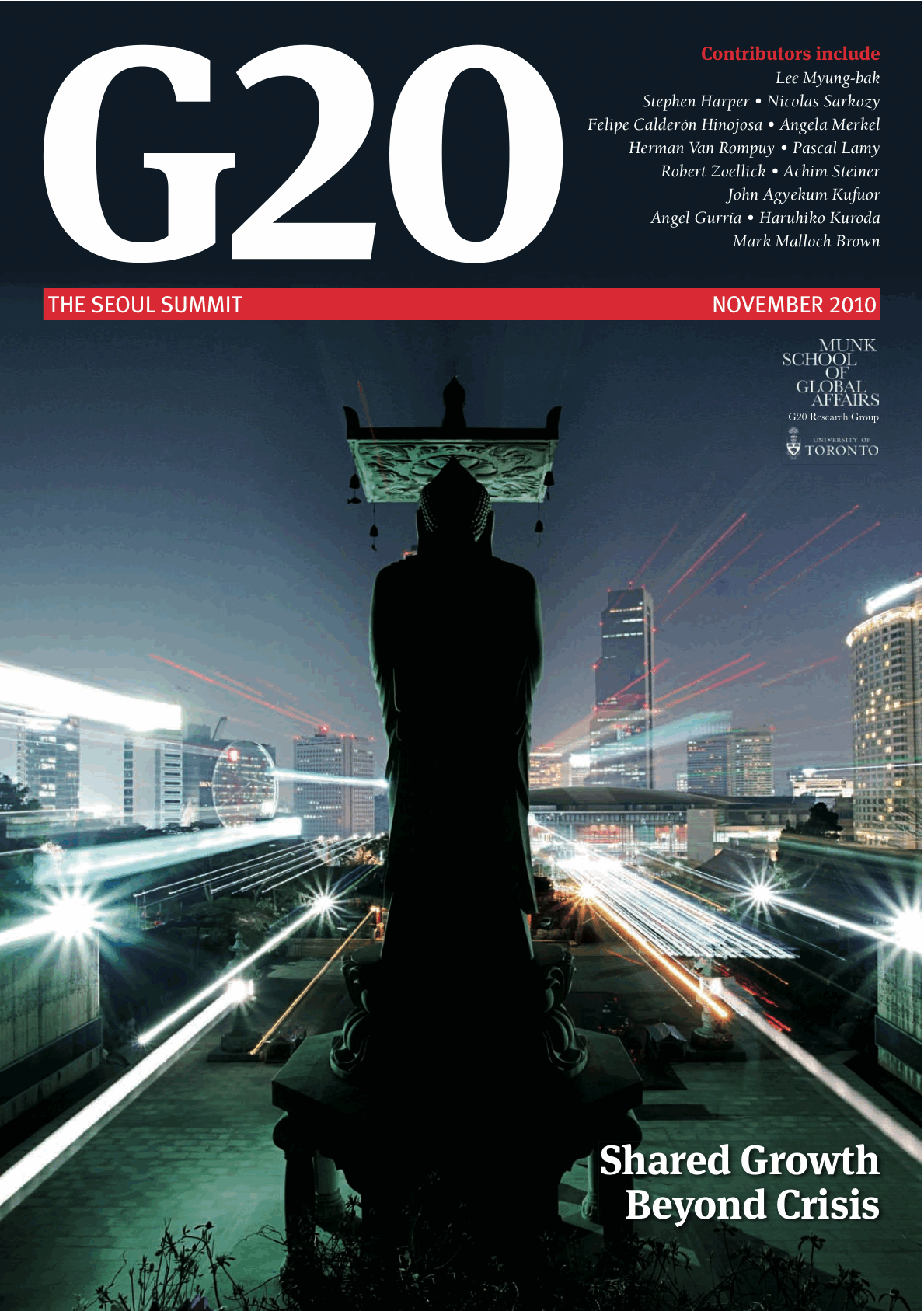

 |
 |
|

G20 and the global economy: time to go structural
By Angel Gurría, secretary general, Organisation for Economic Co-operation and Development
The Organisation for Economic Co-operation and Development is calling for governments to formulate a structural approach to recovery and growth
To download a low-resolution pdf, click here. (Be patient! It's 50 MB.)
The economic storm is behind us, but its outer ‘rain bands’ might still make the world economy pitch and toss. This is a metaphorical way to depict the current state of the global economy. On the one hand, the global economic recovery is taking hold, and growth is likely to pick up next year. The Organisation for Economic Co-operation and Development (OECD) draws comfort from the large corrections that have already occurred in balance sheets, residential construction activity and inventory levels. A double-dip recession in G20 countries looks unlikely. Governments are reaping the benefits of policy coordination crafted in the swiftest manner at the Pittsburgh and Toronto summits. Most governments successfully limited the impact of the crisis, thanks to prompt actions to restore confidence in financial markets and coordinated efforts to bolster demand. Moreover, world leaders refrained from raising new barriers to investment and trade and avoided misguided labour market policies, thus heeding the lessons from past major economic downturns. The key role that trade is playing in the current upturn is there to remind the world of the fundamental benefits of keeping markets open.
Yet the world economy is emerging from the crisis with deep scars. The OECD estimates that the crisis has permanently lowered the level of OECD area economic output by about 4 per cent, due in part to a higher cost of capital and long-term unemployment. At the same time, budget deficits have risen sharply in advanced economies, with government debt in the OECD area likely to outstrip gross domestic product next year.
Further complicating the situation is a slowing pace of economic recovery. While this was expected, the slowdown is more pronounced than anticipated. Moreover, downside risks are accumulating. A renewed decline in housing prices in the United States cannot be brushed aside. That would provoke a negative feedback onto private demand, with possible spillover effects on global demand and growth. In this adverse scenario, financial conditions could worsen if economic weakness led to new losses for banks, possibly amplified by heightened concern over sovereign debt in fiscally weak countries.
Uncertainty about employment prospects is also high and is a factor constraining consumption. Unemployment remains unacceptably high in advanced economies at close to 9 per cent on average in OECD countries, equivalent to around 45 million people. Long-term unemployment has increased sharply, for example in the United States, Ireland and Spain. A particular concern is that unemployment is concentrated among vulnerable groups, notably youth, unskilled and migrant workers.
Furthermore, the unevenness of aggregate demand is putting pressure on exchange rates. In the context of a hesitant recovery and persistent high unemployment, issues relating to exchange rates are becoming fractious: on the one hand, some governments in advanced economies are under increasing pressure to undertake unilateral protectionist actions; on the other hand, authorities in developing countries are confronted with the destabilising impact of massive capital inflows stemming from accommodative monetary policies in mature economies. Albeit complex, the current situation is no reason to let the protectionist genie out of the bottle, which would threaten the global economic recovery.
In this complex and arduous environment, many policy challenges lie ahead. Yet policymakers have little room to manoeuvre on the macroeconomic front. Macroeconomic policy has to tread a delicate path between much-needed fiscal consolidations on the one hand and support to a fragile recovery on the other. Appropriate macro policies are needed to sustain the recovery and address underlying fragilities: governments need to reconcile policy normalisation with continued support, where and when needed.
In this context, policy recommendations must be carefully differentiated across countries as the latter are now at different stages. The consolidation should be faster, the weaker the state of public finances, the greater the difficulties to fund debt, the stronger the economy, the lower the short-term multiplier effects, the greater the scope for monetary policy to offset these multiplier effects and the larger the adverse long-term growth effects from delaying consolidation.
The deterioration in public finances, particularly in Europe, calls for consolidation to restore long-term fiscal sustainability. This should be a gradual process, however, in order to avoid nipping the recovery in the bud. Automatic fiscal stabilisers should be allowed to operate along the planned consolidation paths, except in countries where market pressures are a prospective concern. Should the slowdown prove protracted, governments might consider reducing the speed at which they consolidate their budgets, but only in those countries that have less impaired fiscal positions or modest ratios of debt to gross domestic product (GDP).
While leeway is limited on the fiscal front, monetary policy can still help consolidate the recovery. With subdued inflation, a temporary weakening in growth and a somewhat stronger fiscal consolidation than looked likely before the summer, central banks can afford to maintain their very accommodative policy stances somewhat longer. They may even consider further quantitative easing or strengthened commitments to keep policy rates close to zero for an extended period if the recovery would exhibit signs of durable weakening. Slower exits or uncoordinated reversals of policy by central banks will not be the magic bullet, however, and should be used sparingly as they may accentuate volatility in currency markets.
With a limited scope for using fiscal and monetary policy, the OECD calls on governments to go structural. Drawing on its ‘Going for Growth’ exercise, the OECD has identified a relevant set of structural policies that would help unleash the growth potential of the G20 economies. It encapsulates such policies as pro-competition reforms in product markets and reforms of the education and tax systems, which would result in an increase in labour productivity, as well as the removal of impediments to labour utilisation through an alleviation of the cost of labour, a reduction in labour market dualism and a restructuring of benefit systems.
Selected pro-growth reform priorities would also contribute to external rebalancing. Specific examples include pro-competition reform in product markets in surplus countries, social protection and financial deepening reforms in surplus emerging-market economies and entitlement and pro-saving reforms in deficit advanced economies.
Structural reforms also have a strong effect on potential growth. Stylised policy simulations by the OECD illustrate the pay-off of collective action within the G20 by focusing on the effects on economic outcomes of a convergence of policy settings within G20 countries. Pro-growth structural measures can also facilitate fiscal consolidation: OECD analysis shows that a 1 per cent cut in structural unemployment through structural reforms would improve the fiscal position of OECD countries by 0.25 points to 0.5 points of GDP on average (according to the 2010 OECD Economic Outlook).
Upon the request of G20 members, these evidence-based results will feed into the development of the G20’s Framework for Strong, Sustainable and Balanced Growth. The framework, launched at the Pittsburgh Summit in 2009 and further elaborated at the Toronto Summit in 2010, is a compact that engages countries to work together to mutually assess the coherence of national policies and their consistency with the common objectives agreed at the G20 level: raise output, create more jobs, lift more people out of poverty and significantly reduce global imbalances. In other words, it aims to achieve the G20 credo of a stronger, sustainable and more balanced growth and accomplish the so-called ‘upside scenario’ for growth that goes beyond the ‘technical’ recovery from the crisis.
As part of the compact, the G20 advanced economies agreed to fiscal consolidation targets, while all members agreed to reforms to rebalance global demand and enhance potential growth in their economies. At the Seoul Summit in November, the framework will be translated into a concrete action plan that will likely emphasise the role of and need for far-reaching structural policies and reforms.
Considerable progress has already been made by G20 economies in meeting their framework-related commitments since Pittsburgh and Toronto. G20 members have planned or started to implement policies that will help meet leaders’ commitments on fiscal policy, measures to strengthen financial regulation and supervision, measures that will promote more balanced global growth and current accounts, and structural reforms to increase potential growth rates. But more action is needed to achieve the objectives of the framework. More coordination is required if governments are to mitigate mounting downside risks and to avoid the self-defeating spiral of go-it-alone policy measures, such as unilateral exchange rate interventions and protectionist barriers.
Against this background of heightened policy challenges, the OECD is ready to help its member and partner countries. The organisation is advising them on how to consolidate their fiscal positions in ways that will not risk choking off a nascent recovery. The OECD structural policy surveillance also offers a basket of policy tools to enhance growth performance by raising productivity and labour utilisation. For the future, the crisis has made the case for ‘rebooting’ the world’s economies and for putting them on a broader and sounder footing. Building on innovation and green growth strategies, the OECD is prepared to help G20 countries look beyond the ongoing recovery and build the blocks of a new and more intelligent type of growth.
The world economy is at a critical juncture that requires more than ever an articulated strategy linking together — and exploiting synergies among — macroeconomic, financial and structural policies. The Seoul Summit is the forum to articulate and agree on such a strategy.
|
This Information System is provided by the University of Toronto Library |
All contents copyright © 2024. University of Toronto unless otherwise stated. All rights reserved.